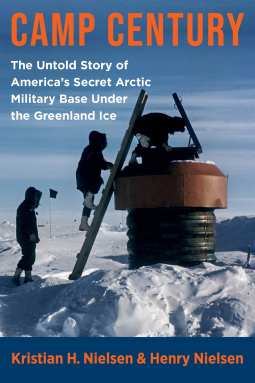
Camp Century
The Untold Story of America's Secret Arctic Military Base Under the Greenland Ice
by Henry Nielsen; Kristian Hvidtfeldt Nielsen
This title was previously available on NetGalley and is now archived.
Send NetGalley books directly to your Kindle or Kindle app
1
To read on a Kindle or Kindle app, please add kindle@netgalley.com as an approved email address to receive files in your Amazon account. Click here for step-by-step instructions.
2
Also find your Kindle email address within your Amazon account, and enter it here.
Pub Date Jul 27 2021 | Archive Date Nov 03 2021
Talking about this book? Use #CampCentury #NetGalley. More hashtag tips!
Description
This book is the first comprehensive account of the U.S. Army’s “city under the ice.” Beginning with the Truman administration’s vision of military superiority in the Arctic and continuing through present-day concerns over the effects of climate change, Kristian H. Nielsen and Henry Nielsen unravel the extraordinary history of this clandestine installation. Drawing on sources including top-secret memos and never-before-seen photographic evidence, they follow the intertwining threads of high-level politics, ice-core research, media representations, daily life beneath the ice, and the specter of long-buried environmental problems that will one day resurface. Camp Century reveals a hidden chapter of Cold War history—and why, as the Greenland ice cap slowly melts, this story is not yet over.
Advance Praise
"Though it only existed from 1959-1966, Camp Century remains a living—and deeply compelling—story today. Its history sweeps across Cold War intrigue to nuclear missiles hidden under ice; from the Arctic’s defeat of nuclear-powered techno-hubris to ice cores at the heart of climate science; and from Danish and American politics to the (now) semi-independent Greenlanders who must live with Camp Century’s legacy as the melting ice reveals its radioactive remains. This lively and intelligent book, beautifully translated from the Danish, gives Camp Century its first full accounting in English."
--Paul N. Edwards, author of A Vast Machine: Computer Models, Climate Data, and the Politics of Global Warming
Available Editions
| EDITION | Other Format |
| ISBN | 9780231201773 |
| PRICE | $30.00 (USD) |
Average rating from 2 members
Featured Reviews
I'll openly confess that I was unaware of the story of Camp Century prior to reading the brief description provided for this book and being intrigued enough to jump at the opportunity to read it in advance.
Camp Century only existed from 1959-1966, a Cold War strategy by the U.S. Army to embed a base deep in the Greenland ice cap. It was officially defined as a "scientific research station," but the facility had the undisclosed purpose of aiming up to 600 nuclear warheads, buried deep within the ice, at the Soviet Union.
Eventually, the challenges would become too great and the political dynamics of the world would change enough that the U.S. would abandon the strategy and abandon Camp Century. However, Camp Century was and remains controversial and has an ongoing impact on diplomatic relationships between the U.S. and its arctic allies.
As climate change increasingly impacts the earth's polar caps, we also deal with the very real reality that Camp Century, once buried within the ice, could resurface and its radioactive waste could impact the now semi-independent Greenlanders.
This book is, indeed, the first truly comprehensive account of Camp Century, from former President Truman's vision of affirming military superiority in this strategic region to the modern-day concerns around climate change. While the Nielsens haven't necessarily been able to access every document desired, what they have accessed is remarkable in depth and detail including never before seen photos, top secret memos, high-level political conversations, ice core research, and more.
"Camp Century" is a remarkably and extensively written account translated from the Danish that captures both past and present with equal enthusiasm and accuracy. At times difficult to read for this decidedly non-scientific mind, I was still enthralled by the history being revealed and the powerful indicators of both politics and science for this camp that was shut down not long after I was born.
For history buffs, this is a slice of American and arctic history never before captured and not soon to be forgotten.



